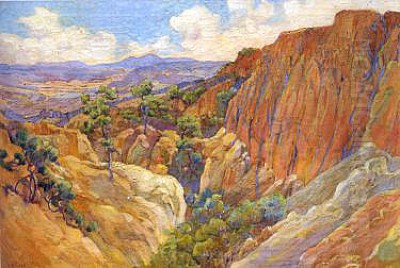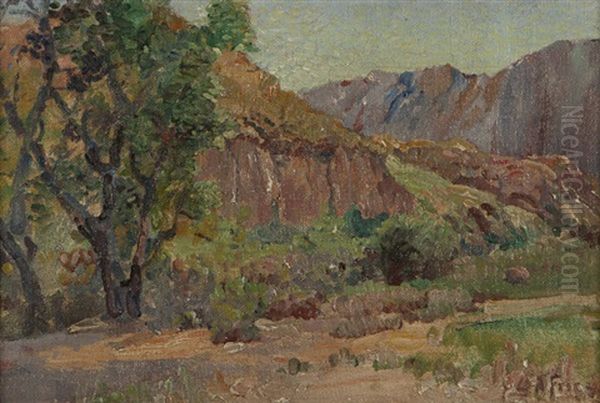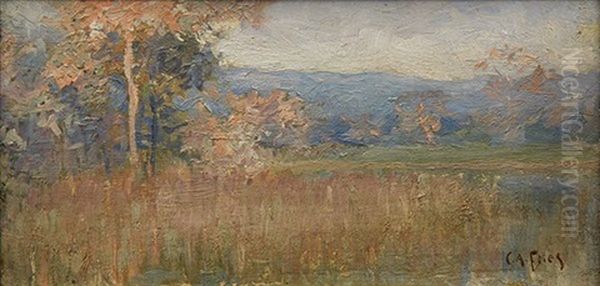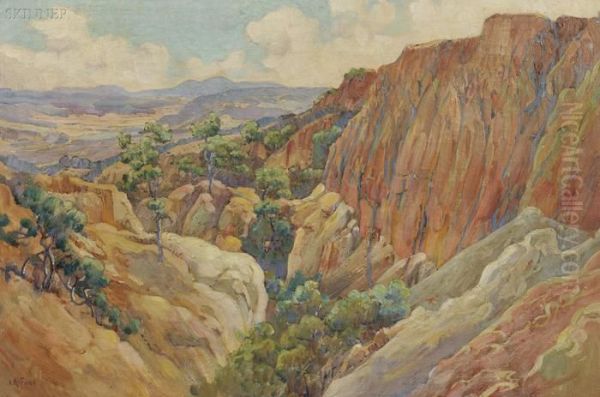
Charles Arthur Fries stands as a significant figure in American art history, particularly noted for his contributions to the California Impressionist movement and his foundational role in the San Diego art scene. Spanning a long and productive career, Fries dedicated himself to capturing the unique light and diverse landscapes of Southern California, leaving behind a rich legacy of paintings that continue to resonate with viewers today. His journey from the Midwest to the Pacific coast reflects a broader trend among American artists seeking new environments and inspirations at the turn of the 20th century.
Early Life and Artistic Formation in the Midwest
Charles Arthur Fries was born on August 14, 1854, in Hillsboro, Ohio, one of seven children born to John and Martha Fries. His formative years were spent in Cincinnati, Ohio, a city that was rapidly developing its own distinct cultural and artistic identity during the latter half of the 19th century. It was here that Fries's artistic inclinations began to take shape. The burgeoning industrial and commercial center provided a stimulating environment, and young Fries showed an early aptitude for drawing and observation.
His formal artistic training commenced at the McMicken School of Design, which later evolved into the Art Academy of Cincinnati. At the time, this institution was gaining recognition as one of the premier art schools in the United States, fostering talents who would go on to achieve national and international acclaim. Studying at McMicken placed Fries within a vibrant artistic milieu. He would have been aware of, if not directly studying alongside, figures who became central to the Cincinnati art scene, such as Frank Duveneck, whose Munich-influenced realism was making waves, and Henry Farny, known for his depictions of Native American life.

Beyond the academy, Fries sought practical skills. At the age of 18, around 1872, he apprenticed with the Gibson & Company, a prominent Cincinnati lithography firm. This training proved invaluable, honing his drafting skills and providing him with a trade. Lithography demanded precision and a keen understanding of tone and composition, skills that would underpin his later work in painting. His proficiency quickly led to professional opportunities. Fries became a staff artist, working as both a photographer-illustrator and lithographer for the Cincinnati Commercial Gazette, one of the city's leading newspapers. This role required him to produce images for publication, further developing his ability to capture scenes quickly and effectively.
During his time in Cincinnati, Fries began painting landscapes of the surrounding Ohio Valley. While his early work likely reflected the prevailing tastes for Realism or the Hudson River School's detailed style, his experiences as an illustrator and lithographer gave him a solid foundation in composition and representation. Other Cincinnati artists active during this period, like Robert Frederick Blum and John Henry Twachtman (who would later become a prominent American Impressionist), contributed to the city's dynamic artistic environment, though their paths would diverge significantly from Fries's later focus.
European Exposure and Broadening Horizons
Like many ambitious American artists of his generation, Fries recognized the importance of European study to further his artistic development. In 1877, he embarked on a trip abroad, primarily visiting the major art centers of London and Paris. This journey was not necessarily for formal academic training in the ateliers, as was common for some, but more for the purpose of absorbing the art of the past and experiencing the revolutionary movements transforming contemporary European art.
In the galleries and museums of London and Paris, Fries encountered a vast range of artistic styles. Critically, he was exposed to the works of the French Impressionists, whose canvases were challenging academic conventions with their bright palettes, broken brushwork, and emphasis on capturing fleeting moments of light and atmosphere. Artists like Claude Monet, Camille Pissarro, and Alfred Sisley were pioneering new ways of seeing and representing the world. While Fries did not immediately adopt a fully Impressionistic style, the exposure to their work undoubtedly planted seeds that would germinate later in his career, particularly their focus on light and outdoor painting (plein air).

Upon returning to the United States, Fries did not immediately settle back into his previous life in Cincinnati. Instead, he sought new opportunities and established a studio in New York City. This period saw him focus more intently on painting, particularly landscapes. He produced works that drew on his experiences, including notable pieces like a panoramic Bird's Eye View of Cincinnati, likely leveraging his skills in detailed observation and composition honed through lithography. His time in New York placed him closer to the center of the American art world, exposing him to the burgeoning American Impressionist movement led by artists such as Childe Hassam and J. Alden Weir, although his own distinct style was still evolving.
The Transformative Move to California
A pivotal moment in Charles Arthur Fries's life and career occurred in 1896. Seeking a change of environment, potentially for health reasons or simply drawn by the growing allure of the West, Fries, along with his wife Addie and their daughter Alice, relocated across the continent to San Diego, California. This move marked a definitive shift in his artistic focus and cemented his place in the annals of California art history. Southern California, with its unique Mediterranean climate, intense sunlight, and dramatically varied landscapes – from coastal bluffs and beaches to arid deserts and rugged mountains – offered a wealth of new subject matter.
Upon arriving in San Diego, Fries quickly established himself within the small but growing artistic community. He set up a studio and began exploring the surrounding region, sketchpad and easel in hand. The transition was profound. The soft, often hazy light of the Midwest and East Coast gave way to the brilliant, clear light of Southern California. This new environment demanded a different approach to color and light, pushing Fries further towards the Impressionist techniques he had encountered in Europe.
He became deeply enamored with the local flora, particularly the towering eucalyptus trees, the gnarled sycamores found in canyons and along riverbeds, and the distinctive Torrey Pines native to the coastal region near San Diego. These motifs would become signatures of his work. He also ventured inland, making numerous sketching trips to the backcountry mountains, such as the Cuyamaca range, and into the arid landscapes of the Anza-Borrego Desert. His dedication to capturing these specific locales earned him recognition as a quintessential painter of the San Diego region.
In San Diego, Fries supplemented his income by teaching art, sharing his knowledge and experience with aspiring local artists. This role, combined with his growing reputation as a painter, positioned him as a respected figure in the community. He was no longer just an artist adapting to a new environment; he was actively shaping its cultural landscape.
Artistic Style: California Impressionism

Charles Arthur Fries is best categorized as an American Impressionist, specifically aligned with the California Impressionist school. While influenced by French Impressionism, his style developed its own distinct characteristics, shaped by the unique conditions of the American West. His work is characterized by a vibrant palette, a sensitivity to atmospheric effects, and a focus on capturing the quality of light specific to Southern California.
Unlike some Impressionists who dissolved form completely into light and color, Fries often maintained a strong sense of structure and draftsmanship in his compositions, likely a legacy of his early training in lithography. His brushwork could be loose and energetic, particularly in capturing foliage or the shimmering effects of light on water, but forms like trees and mountains usually retained their solidity. He excelled at depicting the interplay of sunlight and shadow, often favoring the warm, golden light of late afternoon or the cool, clear light following a rain shower.
His subject matter was predominantly the Southern California landscape. He became particularly known for his depictions of eucalyptus trees, capturing their tall, slender forms and the distinctive way light filtered through their leaves. His paintings of sycamores often highlighted their white, mottled bark and sculptural branches, typically set within riparian environments. Desert scenes showcased his ability to render the stark beauty of arid landscapes, capturing the unique colors of the sand, rocks, and sparse vegetation under the intense desert sun. Coastal views and depictions of the rolling hills and valleys around San Diego also feature prominently in his oeuvre.
Compared to some of his California contemporaries, Fries's style might be seen as less decorative than that of Franz Bischoff, known for his vibrant floral still lifes and later, richly colored landscapes. It was perhaps less ruggedly structural than the work of William Wendt, often called the "dean" of Southern California painters himself for his powerful depictions of rolling hills. Fries shared an interest in atmospheric effects with artists like Granville Redmond, who was also known for his Tonalist scenes alongside his more Impressionistic poppy fields, but Fries generally employed a brighter palette than Redmond's Tonalist works. His focus remained steadfastly on the faithful, yet expressive, representation of the specific places he loved.
Representative Works and Signature Themes
While a definitive list of titled masterpieces can be challenging due to Fries's prolific output and variations on themes, certain subjects and types of paintings are strongly associated with him. His numerous depictions of eucalyptus groves are perhaps his most iconic works. These paintings often feature tall trees dominating the composition, their slender trunks reaching towards the sky, with dappled sunlight filtering through the leaves onto the ground below. Titles like Eucalyptus Trees, Sunlight and Shadow, or A Grove of Eucalyptus appear frequently.
His paintings of the San Diego backcountry capture the region's unique topography. Works depicting Mission Valley, the Cuyamaca Peaks, or the rolling hills near El Cajon showcase his ability to render expansive vistas and the particular quality of light in these areas. He was adept at capturing different times of day and weather conditions, with paintings like After the Rain demonstrating his skill in portraying the fresh, clear atmosphere and saturated colors following a storm.
Desert landscapes, often painted during sketching trips to areas like the Borrego Valley, form another important part of his work. These paintings convey the vastness and solitude of the desert, using warm earth tones and capturing the intense sunlight characteristic of these arid regions. His depictions of native sycamores, often found along creek beds, highlight the contrast between the trees' pale bark and the surrounding foliage, showcasing their unique, often contorted forms.
Fries also painted coastal scenes, capturing the cliffs, beaches, and ocean views near San Diego and La Jolla. Furthermore, intimate portraits exist, including a known oil painting of his daughter, Alice, situated within the familiar San Diego landscape, blending portraiture with his love for the region. His work consistently reflects a deep connection to the Southern California environment, rendered with an Impressionist's sensitivity to light and color, but grounded in careful observation.
Leadership in the San Diego Art Community
Charles Arthur Fries was more than just a painter of the San Diego landscape; he was instrumental in fostering the region's artistic growth. His long residency, respected artistic practice, and willingness to teach and organize made him a central figure, earning him the affectionate title "Dean of San Diego Painters." He played a crucial role in establishing and leading several key arts organizations that helped cultivate a supportive environment for artists and promote art appreciation among the public.
In 1918, Fries was a key figure, alongside fellow artists Maurice Braun and Alfred Mitchell, in founding the La Jolla Art Association. This organization provided a crucial venue for local artists to exhibit their work and engage with the community. It quickly became an important hub for the burgeoning art scene in the La Jolla and greater San Diego area, hosting regular exhibitions and fostering camaraderie among artists. Fries remained actively involved, serving in leadership roles, including as president of the associated Art Guild in 1929.
His leadership extended beyond La Jolla. Fries also served as president of the San Diego Art Guild, another vital organization supporting local artists. Furthermore, in 1929, he became a founding member of the Associated Artists of San Diego, demonstrating his ongoing commitment to collaborative efforts within the art community. Through these activities, Fries helped to professionalize the San Diego art scene, creating opportunities for exhibition, education, and mutual support that benefited generations of artists. His influence was felt not only through his own paintings but also through his mentorship and community building.
Wider Recognition and Illustration Work
While deeply rooted in San Diego, Charles Arthur Fries's reputation extended beyond Southern California. His work was included in significant exhibitions across the country, bringing his depictions of the California landscape to wider audiences. He exhibited in major art centers such as New York, San Francisco, and Berkeley, participating in important shows like those held at the Panama-California Exposition in San Diego (1915) and the Golden Gate International Exposition in San Francisco (1939). This national exposure helped solidify his standing within the broader context of American Impressionism.
In addition to his landscape painting, Fries continued to utilize his skills as an illustrator, contributing work to nationally recognized publications. His illustrations appeared in popular magazines like Leslie's Monthly Magazine and, significantly, in the widely distributed McGuffey's Readers. These readers were standard school textbooks across the United States for decades, meaning Fries's illustrations reached an enormous audience of young learners, subtly shaping their visual understanding of various subjects and stories. This aspect of his career highlights his versatility and his ability to connect with a broad public beyond the fine art world.
His participation in national exhibitions placed his work alongside that of other prominent American artists. While direct collaborations or documented rivalries with famous painters are scarce, his exhibition history means his work was seen in the context of leading figures of American Impressionism like Childe Hassam, Willard Metcalf, and fellow California Impressionists such as Guy Rose, Edgar Payne, and Alson S. Clark. His consistent focus on the Southern California landscape helped define that region's representation within the national art scene.
Contemporaries and Context in California Impressionism
Charles Arthur Fries worked during the golden age of California Impressionism (roughly 1890s-1930s). He was part of a vibrant generation of artists drawn to the state's unique light and landscape. Understanding his work involves placing it within this context and recognizing his interactions and relationships with fellow artists.
His co-founders at the La Jolla Art Association, Maurice Braun and Alfred Mitchell, were significant figures in their own right. Braun was known for his mystical, light-filled landscapes, often imbued with a Theosophical sensibility. Mitchell, a student of Fries, became known for his robust landscapes and coastal scenes. Fries's role as a mentor connected him to younger generations of San Diego artists.
Beyond his immediate circle, Fries was a contemporary of the major figures who defined California Impressionism. William Wendt, based primarily in Los Angeles and Laguna Beach, painted powerful, structured landscapes emphasizing the underlying forms of the land. Guy Rose, who spent significant time in Giverny and was deeply influenced by Monet, brought a more purely French Impressionist style to his depictions of the California coast and Sierra Nevada mountains. Edgar Payne became renowned for his dramatic Sierra Nevada landscapes and vibrant European and harbor scenes.
Granville Redmond, known both for his Impressionistic poppy fields and his more Tonalist moonlit scenes, was another key contemporary, working primarily in Northern and Central California before moving south. Franz Bischoff, initially celebrated for ceramics, turned to landscape painting, creating richly colored canvases. Alson S. Clark, like Rose, had strong ties to French Impressionism and Giverny, applying a sophisticated technique to California subjects. Women artists also played a crucial role, including Marion Kavanagh Wachtel, known for her delicate watercolors, often working alongside her husband Elmer Wachtel. Others like Benjamin Chambers Brown, famous for his poppy scenes, and Anna Althea Hills, a leader in the Laguna Beach art colony, further enriched the movement. Fries's work, with its specific focus on the San Diego region and his characteristic style, holds a distinct place within this talented cohort.
Later Years and Enduring Legacy
Charles Arthur Fries remained an active painter and a respected member of the San Diego art community well into his later years. He continued to paint the landscapes he loved, exploring the familiar motifs of eucalyptus, sycamore, desert, and coast with enduring passion. His studio in downtown San Diego, and later a home studio, remained hubs of artistic activity. He witnessed significant changes in the art world, with Modernism gaining ascendancy, but he largely remained true to his Impressionistic roots, dedicated to capturing the beauty of the natural world as he perceived it.
His long life allowed him to serve as a bridge between the pioneering days of the San Diego art scene and its more established mid-century presence. His dedication to teaching and organizing left a lasting institutional legacy through organizations like the La Jolla Art Association. His influence extended through the many students he taught and the artists he mentored and worked alongside.
Charles Arthur Fries passed away in San Diego on December 15, 1940, at the age of 86. He left behind a substantial body of work that documents the Southern California landscape at a specific period, viewed through the lens of American Impressionism. Today, his paintings are held in numerous public and private collections, ensuring his contribution is not forgotten. Major institutions holding his work include the San Diego Museum of Art, the San Diego History Center, and The Irvine Museum Collection at the University of California, Irvine, which specializes in California Impressionism. His work continues to be appreciated for its technical skill, its evocative portrayal of light and atmosphere, and its historical significance as a record of the region's natural beauty.
Conclusion: A Painter of Light and Place
Charles Arthur Fries occupies a vital position in the history of American art. As a key figure in the California Impressionist movement and the undisputed "Dean of San Diego Painters," his career reflects both a personal artistic journey and the broader cultural development of Southern California. From his early training in Cincinnati to his transformative move west, Fries dedicated his life to capturing the unique interplay of light, color, and form in the landscapes he encountered. His depictions of eucalyptus trees, desert vistas, and coastal scenes remain iconic representations of the region. Beyond his own artistic output, his role as a teacher, mentor, and organizer helped build the foundations of the vibrant San Diego art community that exists today. Fries's legacy endures in his luminous canvases and in the artistic institutions he helped to establish, securing his place as a significant painter of light and place.